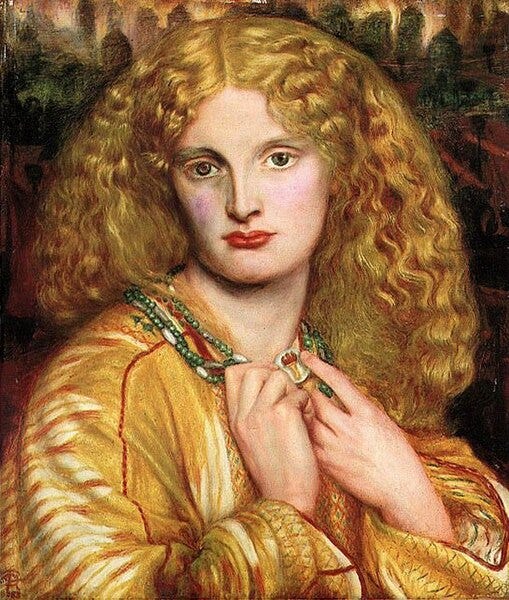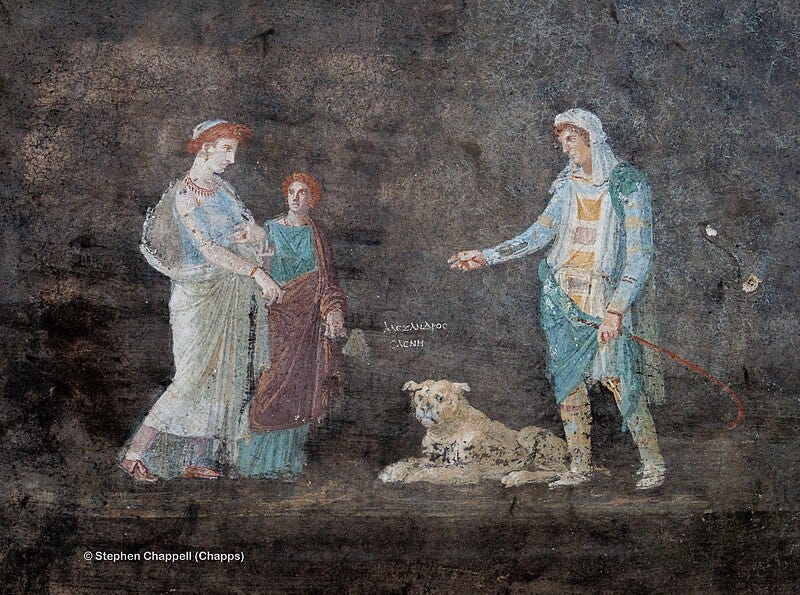This post is a continuation of my substack on the Iliad. All proceeds from the substack are donated to classics adjacent non-profits on a monthly basis. Last year this substack provided over $2k in charitable donations. Don’t forget about Storylife: On Epic, Narrative, and Living Things. Here is its amazon page. here is the link to the company doing the audiobook and here is the press page. I am happy to talk about this book in person or over zoom.
I have written about trauma and the Iliad in several posts. Last year, I provided an overview of work on psychology and Homer. Part of what I explain there is that there was resistance in much of the 20th century to applying modern psychological notions to Homer thanks in part to the work of “progressivists” like Bruno Snell who argued that early texts show a more primitive approach to human thought and emotion. It took two generations to upend such mistaken frameworks that both overestimated the ‘evolution’ of human neurobiology over a few thousand years and tragically underestimated the significance of different cultural and aesthetic categories.
To put it simply, oral poetry and epic in performance convey the depths of human thought and emotion in its full range. But they do it differently from what we see in modern art and literature. To put it in a more contested way: interpreters in the 19th and 20th centuries were motivated in part by a teleological worldview that positioned their understanding and aesthetics at the peak of human development. In order to justify their own beliefs–both about their superiority to earlier cultures and their supremacy over other contemporary peoples–-they had to simultaneously raise up the achievements of their ‘cultural forebears’ while also emphasizing how they have superseded their exemplary predecessors.
That’s too many words to introduce how things changed: in 1994, Jonathan Shay published his Achilles in Vietnam: Combat Trauma and the Undoing of Character and completely demolished the prohibition against talking about Homer in terms shared with modern psychology. His follow-up, Odysseus in America: Combat Trauma and the Trials of Character, was somewhat less heralded critically, but has been part of a cultural shift in the way people talk about Odysseus. I don’t think that Passolini’s The Return or Epic: The Musical would characterize Odysseus the way they do without the larger cultural conversation about the trauma suffered by warriors and the literature about it.
One of the things that I worry about in my own book on Homer and psychology (now free in ebook form) is how we can talk about theories of mind and psychology in epic while only talking about warriors. Shay’s work is ground-breaking and arises from his clinical efforts with veterans, so it isn’t fair to criticize it for overlooking women, children, and enslaved people as well. But one of the powerful things about the Iliad and the Odyssey is how they show the impact of violence on entire communities.
In recent years, Franco Maiullari has written about Andromache as a traumatized character and Fabian Horn has discussed Hektor in similar terms. Each of these papers contributes to a growing bibliography charting the way that war warps bodies and scars minds. Late last year, Caroline Murphy-Racette joined this group with her paper “Helen and Trauma Narrative in the Iliad.”

This article is an important addition to the ongoing conversation for a few reasons. First, it takes Helen’s characterization seriously as “an abducted woman who lives in a war zone” (283). Second, it looks at Helen’s own speeches for evidence of trauma stress and sexual assault in the way she blames herself and engages in suicidal ideation. Third, it enters into a longstanding debate about Helen’s culpability and positionality that brings more range and depth to her character.
Murphy-Racette outlines her theoretical frameworks and potential objections to applying trauma studies to premodern texts in the first part of the paper, emphasizing, rightly, that “forms of trauma existed before modern theorizing” (285). In addition to post traumatic stress disorder, she also introduces studies from “continuous traumatic stress” which also helps us to frame Helen as someone who has not only survived harm but has suffered long term psychological strain from assault, the threat of violence, and the impact of a siege.
Much of the history of reflecting on Helen has not taken her experiences seriously. Countering this, Murphy-Racette suggest that “Helen faces multiple experiences that are potentially traumatizing: she is embroiled in a war, faces isolation and harassment from the Trojans, and is subject to sexual assault (see Roisman 2006.2, 7–8, 32)” (286). Murphey-Racette then analyzes Helen’s speeches in the Iliad to show the impact of sexual violence (3.399–412), the way Helen uses self-blame, which is a common response to sexual assault (e.g. 6.355–56) and how she engages in suicidal ideation (e.g.6.345–48). Murphy-Racette also takes a short detour to the Odyssey to suggest that her use of drugs there reflects an understanding of pharmacological responses to trauma.

As Murphy-Racette states in her closing, this study is limited, but it provides an important example for taking the depiction of women in Homer more seriously. I find it entirely persuasive, with the caveat that these depictions are also ambiguous. Rather than insisting that this is the only way to understand Helen’s depiction, this argument makes it clear that the experiences and understanding of the audience must be taken into account when interpreting Homeric characters psychologically.
Just as audience members today who are unfamiliar with vulnerability, sexual violence, or the expectation of subordinating one’s desires to someone stronger may see Helen in one way, so too would ancient women and enslaved people have understood rather different motivations for Helen’s actions than those in traditional positions of power. This article is both a corrective for masculine-centered readings of the Iliad and a guide toward recuperating the experiences of ancient audience members.
Ancient audiences had intimate familiarity with war and violence. Many people in the world today do as well; but many of us, in something of a historical accident, are voyeurs through traditional media and social media to violence and sieges meted out upon powerless populations. Our response to Helen’s character is as much an indication of how we see ourselves and the world as is our response to suffering dealt out by the powerful to those who can choose only between losing more each day or dying. Homer doesn’t make make Helen a victim or a villain, but we do, just as we explain away the violence done in our names by turning the innocent and disenfranchised into threats of our own making.
A short, incomplete bibliography on trauma and Homer
Christensen, Joel P.. The many-minded man: the « Odyssey », psychology, and the therapy of epic. Myth and Poetics; 2. Ithaca (N. Y.): Cornell University Pr., 2020.
Christensen, Joel P.. “ The Clinical Odyssey: Odysseus’s apologoi and narrative therapy.” Arethusa, vol. 51, no. 1, 2018, pp. 1-31. Doi: 10.1353/are.2018.0000
Horn, Fabian. “The psychology of aggression: Achilles’ wrath and Hector’s flight in Iliad 22.131-7.” Hermes, vol. 146, no. 3, 2018, pp. 277-289. Doi: 10.25162/hermes-2018-0023
Lesser, Rachel H.. Desire in the « Iliad »: the force that moves the epic and its audience. Oxford: Oxford University Pr., 2022.
Maiullari, Franco. “Andromache, a post-traumatic character in Homer.” Quaderni Urbinati di Cultura Classica, N. S., no. 113, 2016, pp. 11-27.
Murphy-Racette, C. (2024). Helen and Trauma Narrative in the Iliad. Arethusa 57(2), 283-316. https://dx.doi.org/10.1353/are.2024.a934136.
Nguyen, Kelly. “ Ocean Vuong, postmemories and the Vietnam War.” International Journal of the Classical Tradition, vol. 29, no. 4, 2022, pp. 430-448. Doi: 10.1007/s12138-021-00605-3
Pache, Corinne. “ weaving « nostos » in Homeric epic and in the twenty-first century.” Combat trauma and the ancient Greeks. Eds. Meineck, Peter and Konstan, David. New Antiquity. New York: Palgrave Macmillan, 2014. 67-85.
Shay, Jonathan. Odysseus in America: combat trauma and the trials of homecoming. New York: Scribner’s, 2002.
Sukava, Tyson. “ Singing a different body:anatomical descriptions in Chapman’s « Iliad ».” Mouseion, vol. 13, no. 1, 2016, pp. 7-34.
Tritle, Lawrence A.. “« Ravished minds » in the ancient world.” Combat trauma and the ancient Greeks. Eds. Meineck, Peter and Konstan, David. New Antiquity. New York: Palgrave Macmillan, 2014. 87-103.
Race, William H.. “Phaeacian therapy in Homer’s « Odyssey ».” Combat trauma and the ancient Greeks. Eds. Meineck, Peter and Konstan, David. New Antiquity. New York: Palgrave Macmillan, 2014. 47-66.
Russo, Joseph. “Re-thinking Homeric psychology: Snell, Dodds and their critics.” Quaderni Urbinati di Cultura Classica, N. S., no. 101, 2012, pp. 11-28.
Russo, J. A. and Simon, B.. “Homeric psychology and the oral epic tradition.” Journal of the History of Ideas, vol. XXIX, 1968, pp. 483-498.
Scodel, Ruth. “Homeric attribution of outcomes and divine causation.” Syllecta classica, vol. 29, 2018, pp. 1-27. Doi: 10.1353/syl.2018.0001
Shay, Jonathan. Achilles in Vietnam: combat trauma and the undoing of character. New York: Maxwell Macmillan, 1994.
Shay, Jonathan. Odysseus in America: combat trauma and the trials of homecoming. New York: Scribner’s, 2002.
Valle Salazar, Luca. “ the social psychology of Odysseus’ fake autobiographies (Od. 14 and 19).” Antichthon, vol. 57, 2023, pp. 1-17. Doi: 10.1017/ann.2023.9





So grateful for these posts -- as both a poet & educator with a lifelong aesthetic & critical obsession with Myth more broadly but Homeric epic specifically, I look forward to these in my inbox. Excited to read The Many-Minded Man too--thanks endless for linking it as an epub. With warmth xxC.